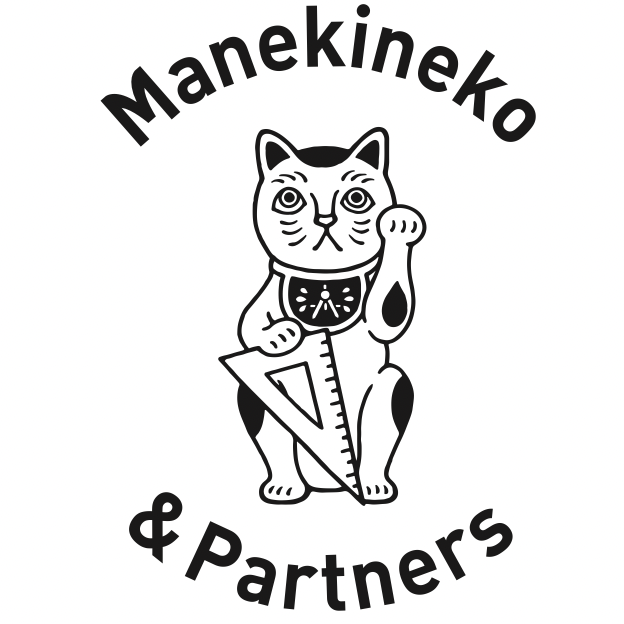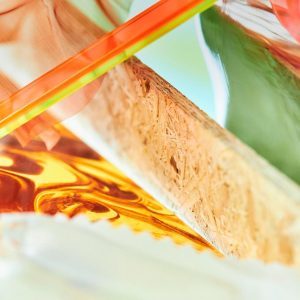- 664
洗濯ブラザーズのクリーニングストア、LIVRER三宿店
LIVRER(リブレ)三宿店は、環境負荷に配慮したマテリアルを多用したクリーニングストアです。
エコな商品開発をしているクライアントからの店舗デザイン依頼に対してどういうアプローチをするか。
インテリアデザインもLIVRERの商品を体現するものでなくてはならない、というのが一つの答えでした。
私たちインテリアデザイナーは自分でマテリアルの開発は出来なくても、
マテリアルの新しい使い方を展開したり、新しい価値を発見し、より発展させることができます。
例えば壁やカウンターの腰で使用した、古紙と廃プラスチックのハイブリッドボード。
このボードは、鶏舎・豚舎の壁・天井材や、現場事務所の床材で使用されることが多い、耐久性が有るゆえの下地材的な役割です。
ただ、この素材は含有されるリサイクル素材の色により、ロット差が有り全く同じマテリアルにはならないという特性があります。
工業製品なのに統一感が無い。それがマテリアルのおもしろい表情に繋がっています。
ポテンシャルがあるのに埋もれていたり、知られていない。
インテリアの表層で使われることが少なく、普段は目にしない。
そういった選択肢に入らないマテリアルを知ってもらうきっかけになったり、新たな可能性を引き出すことができるのがインテリアデザイナーの役割だと考え、今回のアワードに応募致しました。
エコな空間と聞くと優しくて温かいといったイメージが思い浮かびますが、マテリアルの組み合わせにより、温かみだけでなくクールな印象にすることも可能です。
LIVRER三宿店は、いかにも温かくてエコ、という店ではなく、見た目はクールで実は環境負荷にも配慮しているインテリアデザインとなっています。
上記のボード以外にも、様々なエコなマテリアルを使用しています。
例えば床のコルクフローリング。
コルクは木の伐採は不要です。コルク樫の生育サイクルに合わせて、表面の樹皮のみ剥ぎ取ります。
その事がコルク樫を活性化し、森林全体の健全化に繋がります。
またコルクというと茶色いイメージが思い浮かびますが、石のような硬質な表情と、柔らかで膝や腰に優しい歩行感を両立できるフローリング材を選びました。
商品を陳列する大きなガラステーブルは、テレビに使われていたブラウン管100%のリサイクルガラスの天板です。
光が当たると波の波紋のような模様が現れます。
テーブル脚は、愛知県産のヒノキの間伐材とステンレスを組み合わせました。
リアルショップの役割として、誰でも入店できることで消費者への訴求がダイレクトです。
店内に入ってすぐの売り場は、洗濯洗剤の量り売りカウンターです。
来店する方が持ち込んだ容器に洗剤を詰めることが可能な仕組みです。
洗濯グッズの物販や、クリーニングの受付、SNS用の動画撮影、ワークショップができるよう、様々なプログラムを盛り込んだ体験設計をしました。
そうすることで、直接来店できる人以外でもSNSを通じてリブレに興味を持ったり、Well-Beingへの理解が進むきっかけづくりに繋がります。
「洗濯」という身近なためあまり意識をせずに行っている行為。
そこへの付加価値として、循環型社会に適した建築資材を使用することや、生活の豊かさを感じられる、そんな店づくりを目指しました。
LIVRER Mishuku store is a cleaning store that uses a lot of environmentally friendly materials for its interior.
What kind of approach should we take to store design requests from clients who are developing eco-friendly products?
One answer was that interior design must also embody LIVERER products.
Even if we interior designers can't develop materials by themselves,
We can develop new uses of materials, discover new values and develop them further.
For example, a hybrid board of used paper and waste plastic used on the waist of a wall or counter.
This board is often used as a wall / ceiling material for poultry houses and pig houses, and as a flooring material for construction site offices.
However, this material has the characteristic that it will not be exactly the same material due to lot differences depending on the color of the recycled material contained.
Although it is an industrial product, there is no sense of unity. That leads to an interesting look of the material.
It has potential, but it is not known.
It is rarely used on the surface of interiors and is not usually seen.
We applied for this award because we thought that it was the role of the interior designer to get to know the materials that are not included in such options and to bring out new possibilities.
When you hear the word "eco-friendly space", you may think of it as gentle and warm, but by combining materials, we can make it not only warm but also cool.
The LIVRER Mishuku store is not a store that is really warm and eco-friendly, but it has an interior design that looks cool and is actually environmentally friendly.
In addition to the hybrid board we just described, we use a variety of eco-friendly materials.
For example, cork flooring on the floor.
Cork does not require tree felling. Only the bark on the surface is stripped according to the growth cycle of the cork oak.
That activates the cork oak and leads to the health of the entire forest.
When I think of cork, I think of it as brown, but we chose a flooring material that has a hard stone-like expression and a soft, knee- and waist-friendly walking feel.
The large glass table on which the products are displayed is the top plate of 100% recycled glass used for TVs.
When exposed to light, a pattern like ripples of waves appears.
The table legs are made of thinned cypress from Aichi prefecture and stainless steel.
The role of the real shop is to appeal directly to consumers by allowing anyone to enter the store.
Immediately after entering the store, the shelf is a corner for selling laundry detergent by weight.
It is a mechanism that allows visitors to fill the containers brought in with detergent.
We designed an experience that incorporates various programs so that the store can sell laundry goods, receive cleaning, shoot videos for SNS, and hold workshops.
By doing so, it will lead to the creation of an opportunity for people other than those who can come directly to the store to become interested in LIVRER through SNS and to advance their understanding of Well-Being.
An act that is done without much consciousness because it is familiar to us as "laundry".
As an added value to that, we aimed to use building materials suitable for a sound material-cycle society and to create such a store where you can feel the richness of life.
エコな商品開発をしているクライアントからの店舗デザイン依頼に対してどういうアプローチをするか。
インテリアデザインもLIVRERの商品を体現するものでなくてはならない、というのが一つの答えでした。
私たちインテリアデザイナーは自分でマテリアルの開発は出来なくても、
マテリアルの新しい使い方を展開したり、新しい価値を発見し、より発展させることができます。
例えば壁やカウンターの腰で使用した、古紙と廃プラスチックのハイブリッドボード。
このボードは、鶏舎・豚舎の壁・天井材や、現場事務所の床材で使用されることが多い、耐久性が有るゆえの下地材的な役割です。
ただ、この素材は含有されるリサイクル素材の色により、ロット差が有り全く同じマテリアルにはならないという特性があります。
工業製品なのに統一感が無い。それがマテリアルのおもしろい表情に繋がっています。
ポテンシャルがあるのに埋もれていたり、知られていない。
インテリアの表層で使われることが少なく、普段は目にしない。
そういった選択肢に入らないマテリアルを知ってもらうきっかけになったり、新たな可能性を引き出すことができるのがインテリアデザイナーの役割だと考え、今回のアワードに応募致しました。
エコな空間と聞くと優しくて温かいといったイメージが思い浮かびますが、マテリアルの組み合わせにより、温かみだけでなくクールな印象にすることも可能です。
LIVRER三宿店は、いかにも温かくてエコ、という店ではなく、見た目はクールで実は環境負荷にも配慮しているインテリアデザインとなっています。
上記のボード以外にも、様々なエコなマテリアルを使用しています。
例えば床のコルクフローリング。
コルクは木の伐採は不要です。コルク樫の生育サイクルに合わせて、表面の樹皮のみ剥ぎ取ります。
その事がコルク樫を活性化し、森林全体の健全化に繋がります。
またコルクというと茶色いイメージが思い浮かびますが、石のような硬質な表情と、柔らかで膝や腰に優しい歩行感を両立できるフローリング材を選びました。
商品を陳列する大きなガラステーブルは、テレビに使われていたブラウン管100%のリサイクルガラスの天板です。
光が当たると波の波紋のような模様が現れます。
テーブル脚は、愛知県産のヒノキの間伐材とステンレスを組み合わせました。
リアルショップの役割として、誰でも入店できることで消費者への訴求がダイレクトです。
店内に入ってすぐの売り場は、洗濯洗剤の量り売りカウンターです。
来店する方が持ち込んだ容器に洗剤を詰めることが可能な仕組みです。
洗濯グッズの物販や、クリーニングの受付、SNS用の動画撮影、ワークショップができるよう、様々なプログラムを盛り込んだ体験設計をしました。
そうすることで、直接来店できる人以外でもSNSを通じてリブレに興味を持ったり、Well-Beingへの理解が進むきっかけづくりに繋がります。
「洗濯」という身近なためあまり意識をせずに行っている行為。
そこへの付加価値として、循環型社会に適した建築資材を使用することや、生活の豊かさを感じられる、そんな店づくりを目指しました。
LIVRER Mishuku store is a cleaning store that uses a lot of environmentally friendly materials for its interior.
What kind of approach should we take to store design requests from clients who are developing eco-friendly products?
One answer was that interior design must also embody LIVERER products.
Even if we interior designers can't develop materials by themselves,
We can develop new uses of materials, discover new values and develop them further.
For example, a hybrid board of used paper and waste plastic used on the waist of a wall or counter.
This board is often used as a wall / ceiling material for poultry houses and pig houses, and as a flooring material for construction site offices.
However, this material has the characteristic that it will not be exactly the same material due to lot differences depending on the color of the recycled material contained.
Although it is an industrial product, there is no sense of unity. That leads to an interesting look of the material.
It has potential, but it is not known.
It is rarely used on the surface of interiors and is not usually seen.
We applied for this award because we thought that it was the role of the interior designer to get to know the materials that are not included in such options and to bring out new possibilities.
When you hear the word "eco-friendly space", you may think of it as gentle and warm, but by combining materials, we can make it not only warm but also cool.
The LIVRER Mishuku store is not a store that is really warm and eco-friendly, but it has an interior design that looks cool and is actually environmentally friendly.
In addition to the hybrid board we just described, we use a variety of eco-friendly materials.
For example, cork flooring on the floor.
Cork does not require tree felling. Only the bark on the surface is stripped according to the growth cycle of the cork oak.
That activates the cork oak and leads to the health of the entire forest.
When I think of cork, I think of it as brown, but we chose a flooring material that has a hard stone-like expression and a soft, knee- and waist-friendly walking feel.
The large glass table on which the products are displayed is the top plate of 100% recycled glass used for TVs.
When exposed to light, a pattern like ripples of waves appears.
The table legs are made of thinned cypress from Aichi prefecture and stainless steel.
The role of the real shop is to appeal directly to consumers by allowing anyone to enter the store.
Immediately after entering the store, the shelf is a corner for selling laundry detergent by weight.
It is a mechanism that allows visitors to fill the containers brought in with detergent.
We designed an experience that incorporates various programs so that the store can sell laundry goods, receive cleaning, shoot videos for SNS, and hold workshops.
By doing so, it will lead to the creation of an opportunity for people other than those who can come directly to the store to become interested in LIVRER through SNS and to advance their understanding of Well-Being.
An act that is done without much consciousness because it is familiar to us as "laundry".
As an added value to that, we aimed to use building materials suitable for a sound material-cycle society and to create such a store where you can feel the richness of life.


